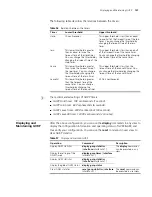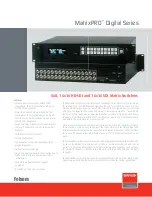
154
C
HAPTER
18: GVRP C
ONFIGURATION
n
■
The value of GARP timer will be used in all the GARP applications, including
GVRP and GMRP, running in one switching network.
■
In one switching network, the GARP timers on all the switching devices should
be set to the same value. Otherwise, GARP application cannot work normally.
GVRP Mechanism
GARP Timers
GARP timers include Hold timer, Join timer, Leave timer and LeaveAll timer.
■
Hold: When a GARP participant receives a piece of registration information, it
does not send out a Join message immediately. Instead, to save the bandwidth
resources, it starts the Hold timer, puts all registration information it receives
before the timer times out into one Join message and sends out the message
after the timer times out.
■
Join: To transmit the Join messages reliably to other entities, a GARP participant
sends each Join message two times. The Join timer is used to define the interval
between the two sending operations of each Join message.
■
Leave: When a GARP participant expects to unregister a piece of attribute
information, it sends out a Leave message. Any GARP participant receiving this
message starts its Leave timer, and unregisters the attribute information if it
does not receives a Join message again before the timer times out.
■
LeaveAll: Once a GARP participant starts up, it starts the LeaveAll timer, and
sends out a LeaveALL message after the timer times out, so that other GARP
participants can re-register all the attribute information on this participant.
After that, the participant restarts the LeaveAll timer to begin a new cycle.
GVRP port registration mode
GVRP has the following three port registration modes: Normal, Fixed, and
Forbidden.
■
Normal: In this mode, a port can dynamically register/deregister a VLAN and
propagate the dynamic/static VLAN information.
■
Fixed: In this mode, a port cannot register/deregister a VLAN dynamically. It
only propagates static VLAN information. That is, a trunk port only permits the
packets of manually configured VLANs in this mode even if you configure the
port to permit the packets of all the VLANs.
■
Forbidden: In this mode, a port cannot register/deregister VLANs. It only
propagates VLAN 1 information. That is, a trunk port only permits the packets
of the default VLAN (namely VLAN 1) in this mode even if you configure the
port to permit the packets of all the VLANs.
GARP operation procedure
Through the mechanism of GARP, the configuration information on a GARP
member will be propagated to the entire switched network. A GARP can be a
terminal workstation or a bridge; it instructs other GARP member to
register/unregister its attribute information by declaration/recant, and
register/unregister other GARP member’s attribute information according to other
member’s declaration/recant.
The protocol packets of GARP entity use specific multicast MAC addresses as their
destination MAC addresses. When receiving these packets, the switch
Summary of Contents for Switch 7757
Page 32: ...32 CHAPTER 1 CLI OVERVIEW...
Page 70: ...70 CHAPTER 5 LOGGING IN USING MODEM...
Page 76: ...76 CHAPTER 7 LOGGING IN THROUGH NMS...
Page 86: ...86 CHAPTER 9 CONFIGURATION FILE MANAGEMENT...
Page 120: ...120 CHAPTER 13 ISOLATE USER VLAN CONFIGURATION...
Page 126: ...126 CHAPTER 14 SUPER VLAN...
Page 136: ...136 CHAPTER 16 IP PERFORMANCE CONFIGURATION...
Page 152: ...152 CHAPTER 17 IPX CONFIGURATION...
Page 164: ...164 CHAPTER 19 QINQ CONFIGURATION...
Page 172: ...172 CHAPTER 21 SHARED VLAN CONFIGURATION...
Page 182: ...182 CHAPTER 22 PORT BASIC CONFIGURATION...
Page 198: ...198 CHAPTER 24 PORT ISOLATION CONFIGURATION...
Page 208: ...208 CHAPTER 25 PORT SECURITY CONFIGURATION...
Page 224: ...224 CHAPTER 27 DLDP CONFIGURATION...
Page 232: ...232 CHAPTER 28 MAC ADDRESS TABLE MANAGEMENT...
Page 240: ...240 CHAPTER 29 CENTRALIZED MAC ADDRESS AUTHENTICATION CONFIGURATION...
Page 280: ...280 CHAPTER 30 MSTP CONFIGURATION...
Page 348: ...348 CHAPTER 35 IS IS CONFIGURATION...
Page 408: ...408 CHAPTER 39 802 1X CONFIGURATION...
Page 412: ...412 CHAPTER 40 HABP CONFIGURATION...
Page 422: ...422 CHAPTER 41 MULTICAST OVERVIEW...
Page 426: ...426 CHAPTER 42 GMRP CONFIGURATION...
Page 480: ...480 CHAPTER 47 PIM CONFIGURATION...
Page 506: ...506 CHAPTER 48 MSDP CONFIGURATION...
Page 552: ...552 CHAPTER 51 TRAFFIC ACCOUNTING CONFIGURATION...
Page 570: ...570 CHAPTER 53 HA CONFIGURATION...
Page 582: ...582 CHAPTER 54 ARP CONFIGURATION SwitchA arp protective down recover interval 200...
Page 622: ...622 CHAPTER 58 DHCP RELAY AGENT CONFIGURATION...
Page 684: ...684 CHAPTER 61 QOS CONFIGURATION...
Page 718: ...718 CHAPTER 63 CLUSTER...
Page 738: ...738 CHAPTER 67 UDP HELPER CONFIGURATION...
Page 752: ...752 CHAPTER 69 RMON CONFIGURATION...
Page 772: ...772 CHAPTER 70 NTP CONFIGURATION...
Page 796: ...796 CHAPTER 72 FILE SYSTEM MANAGEMENT...
Page 802: ...802 CHAPTER 73 BIMS CONFIGURATION...
Page 814: ...814 CHAPTER 74 FTP AND TFTP CONFIGURATION...
Page 830: ...830 CHAPTER 75 INFORMATION CENTER...
Page 836: ...836 CHAPTER 76 DNS CONFIGURATION...
Page 852: ...852 CHAPTER 77 BOOTROM AND HOST SOFTWARE LOADING...
Page 858: ...858 CHAPTER 78 BASIC SYSTEM CONFIGURATION DEBUGGING...
















































